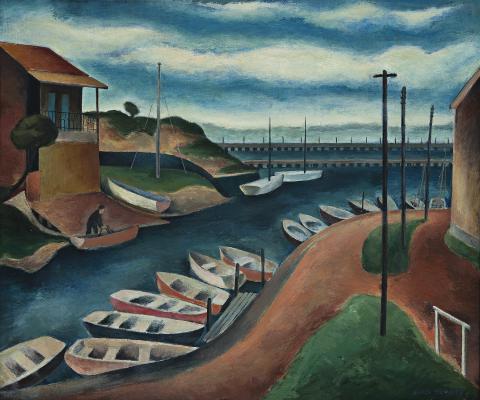RIVER ANCHORAGE, c.1947
ALAN SUMNER
oil on board
50.5 x 61.0 cm
signed lower right: ALAN SUMNER
Golden Age Gallery, Ballarat
James Agapitos and Ray Wilson, Sydney
Gregson Flanagan Fine Art, Perth, 10 March 1997, lot 62
Private collection, Tasmania
Melbourne Contemporary Artists, Victorian Artists’ Society, Melbourne, 18 – 30 October 1949, cat. 51
River Anchorage, c. 1948, screenprint, edition of 38, 40.2 x 49.0 cm image, collection of the National Gallery of Victoria
The bayside regions of Melbourne have provided imagery for a myriad of artists from the earliest days of settlement, and those scenes painted by Alan Sumner are among the most memorable and accomplished. His particular interest lay in the inlets and river mouths where boats were moored, clustered in rhythmic and colourful groupings which naturally attracted the artist’s eye. For Sumner, there was also the personal element of familiarity drawn from childhood memories of holidays at Frankston and Seaford, a refreshing change from the urban streets of inner-city Collingwood where he was born, married and lived for his entire life.
Sumner was a rigorously trained artist having briefly studied at the National Gallery School, Melbourne before coming under the influence of his great mentor George Bell in 1933. His concurrent employment at E.L. Yencken and Co.’s stained glass company also brought him into contact with a wide variety of artists, attracted in part by his charismatic boss, the Scots-born William ‘Jock’ Frater, himself a pioneer of modernist art in Australia. Sumner studied with Bell for six years and his fellow students included Russell Drysdale, Sali Herman, Frances Bourke, and Peter Purves Smith, amongst many other notable names. He was also lucky enough to be the first to see Ian Fairweather’s paintings when the nomadic artist stopped by Yencken’s to meet Jock Frater in 1934. Following service in World War Two, Sumner commenced work at the National Gallery School as Assistant Instructor to William Dargie. He later became the School’s Director and was awarded an MBE in 1979.
George Bell taught his students a style of modernism – essentially a decorative form of ‘soft Cézanne-ism’ – championed by the British artist Roger Fry and critic Clive Bell. Sumner taught his Gallery School students in a similar manner and such principles are evident in River Anchorage, a tranquil morning scene at the mouth of Mordialloc Creek.1 With the horizon demarcated by double bands formed by the Mordialloc pier, the eye is drawn to the foreground by a combination of the pronounced sweep of the creek as well as the repetitive shapes of the boats which punctuate the trajectory. Sumner’s ingrained understanding of design is also on full display with the rounded lines of the headland and island mirroring the creek, and the patches of grass to the right leading the eye back up into the composition. River Anchorage, c.1947 started as an en plein air sketch in the company of his students and was subsequently completed by the artist at his Collingwood studio, where he tinkered with the design and colours until it became ‘an orchestration of pictorial structure, balance and rhythm.’2 Sumner strived for the moment ‘(w)hen a work is properly designed, there is an inevitability about it, a kind of order. I have always had a strong desire towards integrity and honesty.’3
Related paintings to River Anchorage include Kananook Creek, Frankston c.1945 in the collection of the McClelland Gallery+Sculpture Park, Victoria and Low tide, Tooradin c.1948 at the National Gallery of Victoria, Melbourne.
1. In an interview in 1993, Sumner remembered this painting as dating from a 1946 excursion with his students. However, as he didn’t start teaching at the National Gallery School until May the following year, it seems he confused the date with 1947. See: Butler, R., Alan Sumner- Screenprints, Eastgate Gallery, Melbourne, 1993, p. 90
2. Heathcote, C., ‘Artist-teachers stay close to old school’, The Age, Melbourne, 5 November 1993, p. 15
3. ‘Artist with many faces’, Frankston News, Melbourne, 21 June 1983
ANDREW GAYNOR
